 This is the 3rd and final portion of my story of my first time to visit downtown Austin, with my camera, with the intention of simply walking around and taking photos of whatever seemed to catch my eye. I had no agenda, no time requirement, and no plan.
This is the 3rd and final portion of my story of my first time to visit downtown Austin, with my camera, with the intention of simply walking around and taking photos of whatever seemed to catch my eye. I had no agenda, no time requirement, and no plan.
I was walking with my Olympus OM-D E-M5 camera, my four lenses, and a flash in my little Domke camera bag, but I had left my small Gitzo GT1542T Traveller tripod back at the car. In parts 1 and 2, I had used the Olympus 12-50mm f/3.5-6.3 zoom lens with a circular polarizer.
You can find Part 1 here, and you can find Part 2 here.
At the end of Part 2, I was on Lamar Blvd. at Whole Foods Market and I had just sat down to change my lens.
Here is the map for the route back to my car at Willie Nelson Blvd. (East 2nd Street) and San Jacinto near the Austin Convention Center.
I had 12mm, 25mm, and 45mm prime lenses in my bag (24mm, 50mm, and 90mm equivalents on a full-frame camera). Based upon my experiences over the previous 75 minutes, I thought the 12mm would be too wide-angle for the majority of the shots. I also knew that I would be walking towards the east, into the morning sun, and I was probably going to encounter lots of backlit subjects. I thought that I would not be shooting as many buildings, but rather architectural features (portions) of buildings and try not to include the sky in the frame, so I opted for the Olympus 45mm f/1.8 lens.
Here is the top of the 41-story Spring Condos , which was 2 and a half blocks away.
Reminder: You can always view any photo at a larger size by just clicking on it. You will then need to use your browser’s “Back Button” to return to my story.
At the corner of Lamar Blvd. and West 5th, sits this old Chevrolet farm truck and the Whole Foods Market signage. I had backed up as far as I could without going over the curb and into this very busy intersection.
I would have liked to include more of the truck and its surroundings, but I was not going to risk going out into the traffic, and this 45mm lens does not zoom.
A block east of Lamar, on the south side of 5th Street is the 29-story Monarch Apartments.
I exposed for the building, and let the sky overexpose, which I somewhat corrected later when I postprocessed the RAW file in Lightroom (using the Adjustment Brush with -0.66 Exposure and +50 Saturation on the sky).
I walked about a half block before coming up on this sheltered bus stop. I set my little Domke camera bag on the bench, next to an empty Coke bottle (where in the heck to you even buy Coke in a bottle anymore? – I assumed Whole Foods Market). My intention was to get a photo of the artwork on the wall that also had some “lovely” graffiti on it.
Once again, I couldn’t seem to get everything into the frame, and I really didn’t want to back into the busy street traffic. I never could get any angle that would have the reflection go away from the front of the artwork.
I decided right then and there that the 45mm lens wasn’t helping me to get the photos that I wanted to get. It was simply too much telephoto for me right now. I changed to the Panasonic Leica 25mm f/1.4 lens, and then went back to the exact same spot where I had taken the photo of the Monarch Apartments with the 45mm lens, and took this photo.
It definitely included much more into the frame. I wasn’t certain that I liked this better yet or not, but I was going to work with it for a while.
Here’s a photo of the back side of the Whole Foods Market headquarters office building.
Moving east on West 5th Street, just before the bridge over Shoal Creek, these wildflowers were growing where the street crews had not mowed. I set the aperture to f/1.8, which was almost as open as this lens can get, just to see how the shallow depth-of-field would look.
Just past West Ave, this “Old and New” caught my eye.
That is the 360 Building, located between 3rd and 4th Streets, towering over the old-style building on 5th Street.
Walking past Rio Grande and Nueces, and looking back over my right shoulder I saw this interesting view of the 360 Building.
In the next block, across from the U.S. Post Office, in the Republic Square Park, the Farmers Market that I told about in Part 1 of this too-long story was in full swing, and it appeared that they had a very good turn-out of customers. It looked like it would be more difficult to photograph now than when I had walked through there just 50 minutes ago. Note to self: get there when they open at 9:00 AM for the best light, and the fewest people.
Nearing Guadalupe Street, I came upon this view of the Frost Bank Tower, that seemed to have the reflection of another building in it, near its base.
Also note the lack of people on the sidewalks. This had pretty much been the case my entire walk, except in the Farmers Market and near the front of Whole Foods Market. I never really encountered any people at all. Maybe this town parties late into the night, and doesn’t get out and about until noon on the next day?
At the corner of 5th and Guadalupe, this caught my eye. I’m not sure why, but for some reason I like this photo.
Lavaca is the name of the next street after Guadalupe, and that building occupied the entire block along 5th Street.
Before coming to Lavaca, looking across 5th Street, I thought this view of the 56-story Austonian towering over Rebels Honky Tonk might make a nice “old and new” photo.
On the southeast corner of West 5th Street and Lavaca sits Antone’s, which is a famous blues club here in Austin.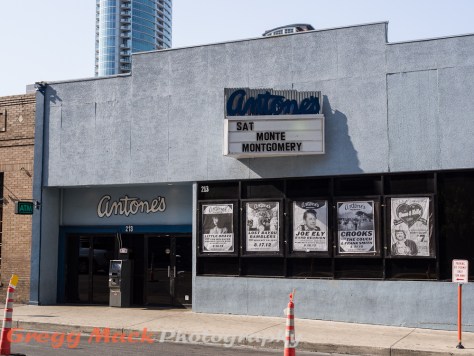
Here’s a view of The Austonian from Colorado and 5th Street.
I was approaching Congress Avenue, and the Frost Bank Tower sits between 4th and 5th Streets on the west side of Congress Avenue.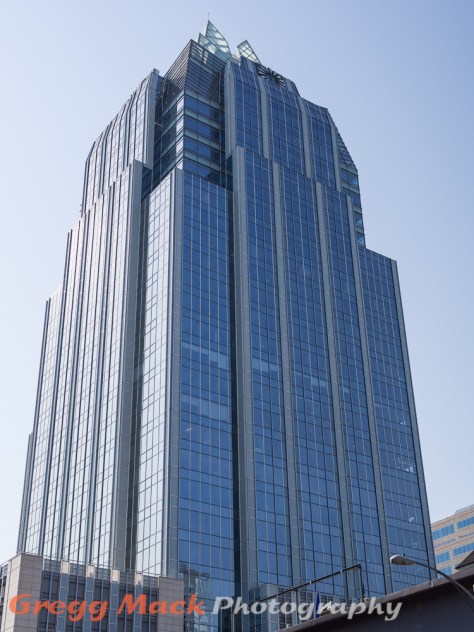
The sun was shining on the other side of the building, so I thought that I would walk over there and see how it would look from that side. To get there, I had to cross Congress Avenue. Half way across, I stopped for just a couple of seconds and took this snapshot of the Texas State Capitol Building, which was 7 blocks north of me. (Remember that I had the 25 mm lens on.)
On the southeast corner of 5th and Congress, at the base of the Frost Bank Tower is the Mexic-Arte Museum.
Along 5th Street, they have this painted on the side of their building.
Just a little bit east of that painting, was this “til death do us part”.
With all of the white wall in the scene, I did add +2/3 stop of exposure compensation to the exposure. The electronic view finder on the mirrorless Olympus camera makes it very easy to “pre-chimp” a settings change like that. I’m still not sure what to think about lipstick on a skull…
Looking up, here’s a view of the northeast corner of the Frost Bank Tower. It looked much better on the sunny side of the building.
Another half block east on 5th Street, between Brazos Street and San Jacinto Blvd, I walked into the Bank of America parking lot, very near the drive-through tellers, and took this photo (also shown as the first photo in this posting).
That’s the 56-story Austonian on the left. It is 683 feet (208 m) tall, and is located on the other side (west) of Congress Avenue, and north of Willie Nelson Blvd (2nd Street). In comparison, the Frost Bank Tower 515 feet (157 m) tall with 33 floors.
OK, so I had satisfied my curiosity of what the Frost Bank Tower would look like on the sunny side, so it was time to head south of San Jacinto Blvd, and back to the CR-V.
Just north of 4th Street, I passed by this threaded stud protruding out of a brick wall. After 10 steps or so, I stopped, turned around, and went back to it.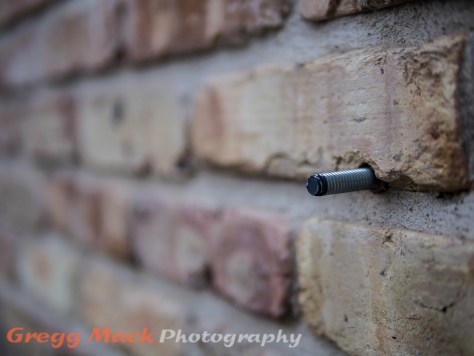
Just to make it somewhat interesting, I opened the aperture all the way to f/1.4 to get the shallowest depth of field that I could with this lens.
At 4th Street, I looked to the southeast, and took this photo. I’m not sure if they are businesses or residences.
There is a new building being constructed on the east side of San Jacinto Blvd, between 3rd and 4th Streets. I do not know what the building will be when it is finished.
Looking back over my right shoulder, this caught my eye.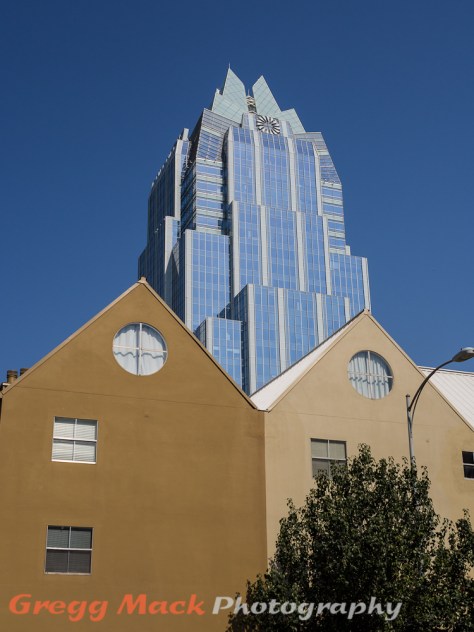
Just a bit more south along San Jacinto Blvd, I snapped this “two in one” kind of photo (left and right).
At the corner of 3rd Street and San Jacinto Blvd, I stopped next to a group of construction workers who decided that they needed to all stop talking and watch me. I figured I had better do something to justify carrying this camera and camera bag, so I simply looked up, snapped this photo, and proceeded to walk away from them.
On the south side of 3rd street, I thought this looked kind of cool, with the base of the crane in front of The Austonian.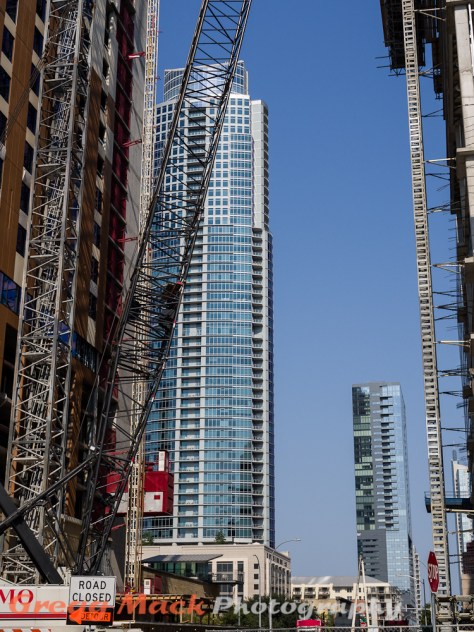
Half way between 3rd and 2nd Streets, on the east side of San Jacinto Blvd. was this big succulent plant with some pretty flowers beneath it. Even though it was all in direct sunlight, which is usually the worst light for flowers, I thought I’d at least try to see if I could get a decent photo of it.
These flowers were in the parking lot on the north side of P.F. Chang’s restaurant.
The Honda CR-V was parked around the opposite side of P. F. Chang’s on Willie Nelson Blvd (2ns Street). But before I went to the car, I took this final “architectural” shot looking east on Willie Nelson Blvd, just so I could later compare the differences in the lighting from when I had started my walk 2 hours and 15 minutes earlier.

And finall, my trusty Honda CR-V.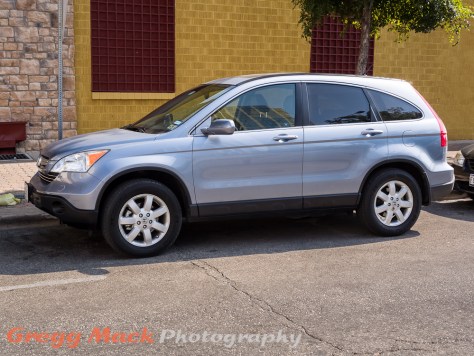
So what did I learn from my first experience of a downtown photo walk?
1. That walking towards buildings, with the sun to your back yields a higher percentage of nice photographs.
2. There are very few people on the streets in the downtown Austin area on a Saturday morning.
3. The 45mm lens (90 mm equivalent) had too much telephoto reach for me to deal with on this initial excursion.
4. While this walk took considerably longer than my normal Saturday morning walk, I would say that the perceived amount of exercise was much less. I did so much starting and stopping, hovering around looking for the best angle to photograph from, that I never felt like I got my heart rate and breathing up to an aerobic level.
5. That it takes 3 times as long to write about a photo walk than it takes to do a photo walk.
I can easily see myself returning multiple more times to downtown Austin to wander around with my camera. I’ll probably zig-zag around, making an effort to walk a different route each time. I highly doubt that I will write about any of those future walks to the level that I documented this one.
For anyone who actually read all of the words that I wrote, I thank you for doing so, and I ask that you write a quick comment letting me know what you think I could do better (including my photography).
I promise that I will never, ever make another post this long again.
Thank you for visiting my blog!
Like this:
Like Loading...


























































































